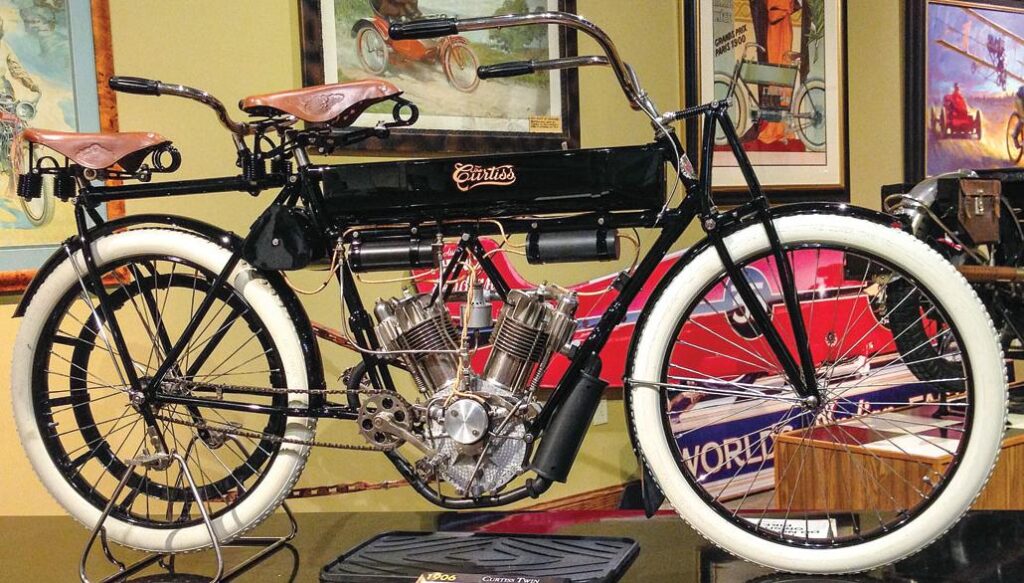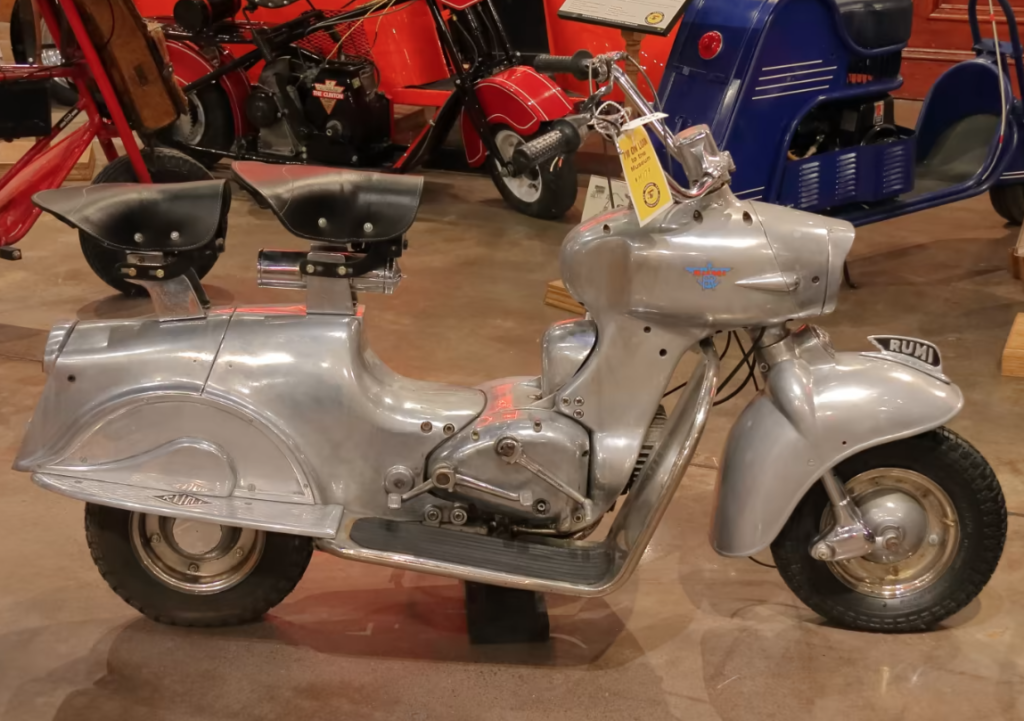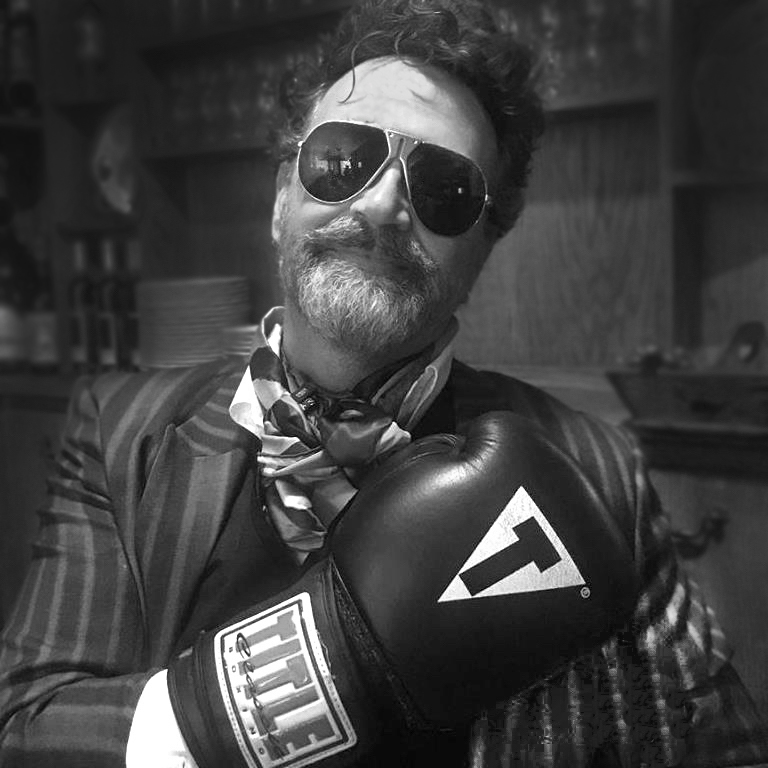September 6-9 at the National Motorcycle Museum in Anamosa, Iowa
From original-paint to original thinking, there’s an amazing diversity of machinery available at the John Parham Estate Auction, hosted by Mecum. It was a tough decision to close the National Motorcycle Museum, but with the death of its primary benefactor a few years ago, it was always going to be a money loser, so the decision was purely practical. It’s sad to lose such an amazing collection in one spot, but on the upside, it makes for an exciting opportunity for folks to find some unique motorcycles. You can bid online, but it’s definitely preferable to show up and see the museum one last time, and catch the energy of the auction, which is always fun. There are hundreds of bikes and even more hundreds of lots of automobilia – posters, engines, photos, and a bunch of cool antique toys. Have a look at the Mecum John Parham Estate Auction page here. And now, my faves from the Museum:


2. 1911 Steco Engineering Co. Aerohydroplane




4. Indian Quarter Midget Racer


5. 1966 Harley-Davidson Electra Glide ‘Willie’s Latin Thing’


6. 1927 Brough Superior SS100 Pendine replica


7. 1956 Rumi Formichino Scooter


8. ‘Dragon Bike’ from The Wild Angels


Assistant Director Peter Bogdonavich watching. The Dragon Bike is iconic. [API press photo]
9. 1940 Indian Model 640 Sport Scout racer


The Indian Sport Scout used a 42-degree V-Twin sidevalve, 45ci (745 cc) motor, and was in production for nine years (1934 to 1942). Indian’s chief engineer and designer, Charles B. Franklin, responsible for the creation of the Scout (1919), Chief (1922) and Scout Pony (1932), roughed-out in sketch form the Sport Scout before his death aged 52, on October 19, 1932. Diverging from Scout’s long running cradled-framed and leaf-spring fork motorcycle (1920 through 1933) the first Sport Scout, similar to the Scout Pony, used a keystone rigid frame through 1940, then used a plunger rear suspension for 1941-42, with a girder fork used on all years. The two-piece frame consisted of a front downtube and rear fork bolted to the engine/transmission unit by front and rear mounting plates. Lack of a frame under the motor/transmission maximized ground clearance during banking and the girder fork offer more front-end travel, making the Sport Scout a good motorcycle for dirt track racing. Tuner alterations to this bike include a BTE twist grip throttle, a modified foot clutch, shortened hand shifter, a special foot-peg set up, a solo/pillion seat setup and a Splitdorf magneto in place of the original battery ignition. It’s interesting to mention that Indian stopped producing this model in 1942, and all the wins in the 1950s were taken on Sport Scouts that were at least 10 years old! It’s a legendary machine, and not easy to find today.
10. 1928 Husqvarna Model 180 V-twin







A very eclectic eccentric most excellent collection indeed … from that ‘ locomotive ‘ monster … to a chopper … and even a biplane … with a scooter … a mega classic ( the Brough ) etc thrown in for good measure .
So yeah … this is a collection I can appreciate from top to bottom
I’d be curious to see what that monster of a ‘ RoadDog ‘ goes for
Here’s the post of my recent visit,
https://myroyalenfields.blogspot.com/2023/08/the-us-national-motorcycle-museum.html
Glad you got to see it Jorge! I think it would have taken thousands of visitors monthly to make the Museum financially viable, and that’s tough when it’s in the middle of Iowa…
Actually Paul … thats pretty much the same problem all museums face . Costs that exceed even the most optimistic potential income . Even the subsidies [ including federally subsidized ] and subscription based museums [ including those in DC ] are dancing on a knife edge on the verge of crashing into the abyss .
So factor in the ‘ black hole ‘ reality of museums ( like wineries .. if you want to make a million … spend ten .. million that is ) … placing said museum in the middle of a state few if anyone has any desire to visit ( .. ok … excepting to attend the Writers Workshop .. wink wink ) ,,, and then the massive amount of dollars it took to amass that collection … and ..
.. unfortunately … it was a disaster just waiting to happen … a beautiful disaster mind you … but a disaster never the less
Having said that though … I do regret never seeing it … thought the blips and snaps ” American Pickers ” offered up do help a bit .
Many interesting machines , but , for me one stands head & shoulders above the rest. Long one of my Heros has been Glenn Curtiss and to own one of his motorcycles would be an honor. He started building V-twins in 1903 , the same year my Grandfather graduated college. Unfortunately for me my Grandfather wasn’t a rider and didn’t buy a Curtiss twin to leave to me.
I heard an argument going on on the legitimacy of the Wild Angels bike. Had you heard anything?
Lots of hearsay on this one. Mil Blair, founder of Easyriders, certified the bike as genuine when he sold it to John Parham. I’ve heard otherwise from sources who know Mil Blair, who claim to have watched him assemble this bike from random parts. Caveat emptor, I cannot confirm or deny.